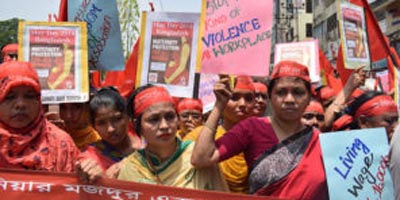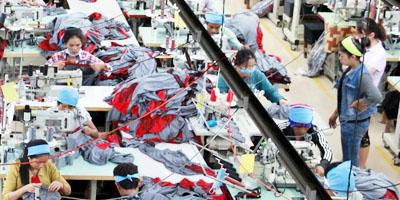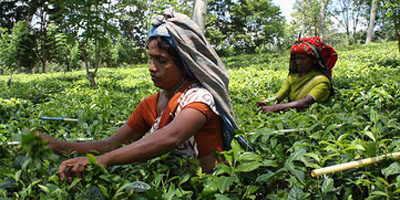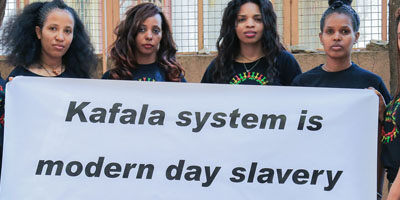On the 24th of April, 2013, millions of people watched their televisions in horror and despair at news updates of the rising toll of the dead and missing in Savaar, Bangladesh, where Rana Plaza, a commercial building home to factories, banks and stores, collapsed early that morning.
The search and rescue continued for just under three weeks before an official death toll of 1,134 was announced. Some 2,500 people were injured. The hazards of the textile industry and the name brands that enabled them were global news, although the industry had flourished under dangerous conditions for over a decade. For example, just several months before a fire in a factory of Tazreen Fashions killed twelve people; compensation to victims was granted inconsistently, if at all.
Months later after the Rana Plaza disaster, brands such as Store 21 denied involvement while Walmart and Auchan admitted there may have been possible illegal or indirect sourcing. Only when investigators dug under rubble for labels on clothes were several brands proven to be involved. The world’s attention was drawn to the fact that well-known brands were associated with terrible working conditions, and protests were launched outside major flagship stores.
Damage control began in earnest by companies such as Loblaw and Primark, who pledged to compensate workers and change the existing supply chain hazards. Despite the intense global media coverage, it took two years before the compensation target of $30 million was reached.
Fire and Building Safety – the 2013 Accord
 More than two hundred major brands including H&M, Inditex (Zara), Joe Fresh, Primark, Esprit, Sainsbury’s and others eventually agreed to work with organisations such as IndustriALL, Clean Clothes Campaign and Maquila Solidarity Network, as well as the Bangladeshi government and the ILO for a long-term safety solution. The result was the May 2013 establishment of the Accord on Fire and Building Safety in Bangladesh.
More than two hundred major brands including H&M, Inditex (Zara), Joe Fresh, Primark, Esprit, Sainsbury’s and others eventually agreed to work with organisations such as IndustriALL, Clean Clothes Campaign and Maquila Solidarity Network, as well as the Bangladeshi government and the ILO for a long-term safety solution. The result was the May 2013 establishment of the Accord on Fire and Building Safety in Bangladesh.
The Accord is a legally binding agreement to promote and improve standards in the textile industry, and to mitigate the effects of existing, unsafe working environments through training, inspections and compensation to the victims and their families. Brands agreed to no longer source from factories that did not comply with the standards, and so factories began to make a gradual transition to safer working environments.
The Accord is unique in three main ways according to Robert Jeffcott, spokesperson for the Maquila Solidarity Network (MSN), an NGO based in Toronto. The first is that inspections are independent and done by professional safety inspectors that are accountable to the Accord. This in turn leads to greater transparency, so that the names of the factories, the problems found in each factory and the corrective action plans as well as progress, are reported as public information on the Accord website. As a result, there is greater public scrutiny over company actions.
The governance, he explains, consists of equal number of both global and Bangladeshi unions and companies or brands who are on the governance body. The ILO acts as the neutral chair. Finally, there are four witness signatories. “MSN is one of the witness signatories,” Jeffcott said. “A representative of these labour rights has voice but no vote at steering committee meetings. It’s very different from the past voluntary initiatives, so the scope is very different as well.”
Joris Oldenziel, Deputy Director for Implementation at the Bangladesh Accord Foundation, says that Accord-trained safety committees – with an equal number of management and workers – will provide a comfortable environment for workers to raise their safety complaints.
Failure of factories to comply with Accord corrective action plans may lead to them being delisted, and the companies they supply become responsible for ensuring that corrective action is taken by the manufacturers. If that is not done in a timely manner, there is an arbitration process.
“There have been two arbitration cases,” Jeffcott said. “The brands are not named, but the settlements in both cases were that the brands would ensure that their supplier factories comply with the corrective action plan. The second thing is that they would provide or secure financing so that the supplier could carry it out. So, it’s not just on the supplier to carry out corrective action, the brands also have responsibilities and that’s also unique to the Accord.”
The brands that did not join the Accord
Twenty-nine retailers that did not join the Accord formed the Alliance for Bangladesh Worker Safety to improve fire, structural and electrical safety in garment factories. These included North American companies such as Walmart, GAP, Target, Canadian Tire, Costco and Giant Tiger. Like the Accord, the Alliance was a five-year agreement to expire in 2018. Unlike the Accord, however, there are no plans to expand the agreement. The Alliance claims that almost 90 % of remediation in its factories is completed. Rather, as stated in its recent press release, its members plan to transfer responsibility to a Safety Monitoring Organisation formed by local partners, which will still be largely funded by the brands.
Local impacts

Thousands of garment workers rally on the one-year anniversary of the Rana Plaza collapse. Photo: Solidarity Center/Sifat Sharmin Amita
Speaking to a factory owner who wished to remain anonymous, I learnt that he and other owners approved of the changes made to improve safety. The owner affirmed that his factory saw routine visits from Accord officials and that they were given set timelines for compliance, made stricter after 2015. However, he explained that the cost of remediation and retrofitting factories was quite high, between 50 – 250 million Bangladeshi taka (roughly CDN $ 0.77 – 3.87 million) depending on factory size, and that not all factories could afford to make these changes when they were often higher than their operating costs. With a push for increasing wages, but stagnant or lower prices for the last fifteen years on garments, almost all factories are struggling in some way financially, he says.
Because of the unhealthy price competition, the factory owner told me that he still loses out if he does not take on contracts that cause him losses instead of gains, because there is always some other supplier who will be willing to accept the lower price despite making a loss.
When asked about other aspects such as the safety committee, he noted that although there was certainly a structure of a complaints’ committee, he had yet to see evidence of its effectiveness.
He drew attention to the fact that no other export industry or residential buildings in Bangladesh had such meticulous compliance regulations and therefore none of the costs. When I asked what changes he would like to see, he suggested perhaps better regulation and control by the Bangladesh Garment Manufacturers and Exporters Association, a national trade organization of garments manufacturers, and more negotiating towards achieving better prices for suppliers, such as an additional percentage to compensate or share the costs of factory remediation.
Jeffcott also thinks there is room for improvement. Generally, brand names are not associated with the factories. Only factory names are disclosed. Ideally, he would have preferred a system where the name of the signatory brand or brands was associated with the supplier factory.
He also hopes that unionisation and the labour movement get stronger. There is a lot of oppression to unionisation in Bangladesh at the moment to which the issues of safety are not unrelated. He believes that stronger unionisation and ability to bargain collectively means improved health and safety.
Extending the Accord

On May 1, 2018, women rally for a living wage, maternity protections, freedom of association and an end to gender-based violence at work. Photo:
Musfiq Tajwar, Solidarity Center
In 2017, the companies and trade unions agreed to extend the Accord after its expiration in May 2018. In 2018, the Accord reported that while the progress made had been slower than predicted, targets would be met before the expiration of the 2013 Accord.
This encouraged brands to sign onto the 2018 Accord that expires on May 31, 2021. It extends the current Accord with additional terms of specific training and a complaints protocol to cover Freedom of Association rights with regard to safety. Signatory brands can now also list their home textiles, fabric and knit accessories’ suppliers and there is a new provision on workers’ severance payments when a factory closes due to Accord remediation. In December 2019, the Steering Committee plans to assess whether a national body is ready to take over the role of the Accord. If not, the Accord will be extended by another year but will hand over responsibility earlier if the national regulatory body is ready.
Brands that do not sign the Accord essentially signal to workers, unions and NGOs that they do not prioritise worker safety, says Christie Miedema, Campaign and Outreach Coordinator at the NGO Clean Clothes Campaign, based in The Netherlands.
As of mid-2018, more than 160 brands had signed on to the revised Accord, which shows a majority consensus to commit to better safety standards in this competitive industry. However, many signatories had to be pushed to sign by unions and NGOs. One reason for this was that several companies considered that the remediation process would be mostly complete as the 2013 Accord ended. Others argued that there was a need to continue investing in improvements, since monitoring safety is a continuous process in factory production.
Petra Brännmark, Communications Director at IndustriALL, said that another reason for delays in re-signing could be the concern some firms had about continuity as responsibility is handed over from the Accord to a national regulatory body. She did not think those concerns were well-founded. “The terms and conditions of the handover are so well defined that there won’t be any trouble,” she said.
When asked about the 2018 Accord, she said, “It’s really encouraging that brands are standing by their commitment to make the Bangladeshi garment industry safe and sustainable.” She further emphasized that the standards and strengths of fire safety and worker rights should ultimately be in the hands of the Bangladeshi people.
The future – national oversight
Christie agrees that a national working body should be where everything comes together.
“A lot of the obstacles faced by the national body will be similar to those the Accord has faced. The Accord has done a lot already to pave the way, and the national body should work with this experience instead of reinventing the wheel,” she said.
“Even if this body is ready to takeover that responsibility, it does not mean brands will not be responsible for the supply chain anymore. They can’t suddenly say it’s out of our hands. It’s the responsibility of both the national body and the brands. Having a code of conduct and pointing to it every time the media asks should become a thing of the past. Hopefully, relying on words instead of real deeds has become a thing of the past as the Accord has shown how this is so successful.”
Even so, Christie wants to see consumer countries take more action.
“The EU, US, Canada and other big buyers could also make sure that their brands are legally responsible for their due diligence, that they can be held responsible and mitigate human rights violations in their supply chain. This path towards more enforcement, away from voluntary commitments that then aren’t followed up, is hopefully and most likely the future.”
Update: At the time of publication, there were more than 185 company signatories to the 2018 Accord, slightly fewer than signed the original Accord.





